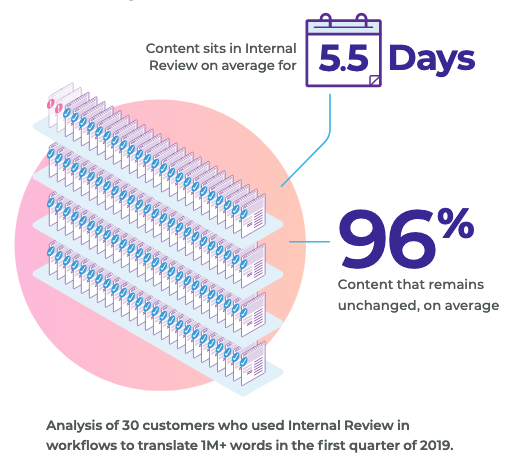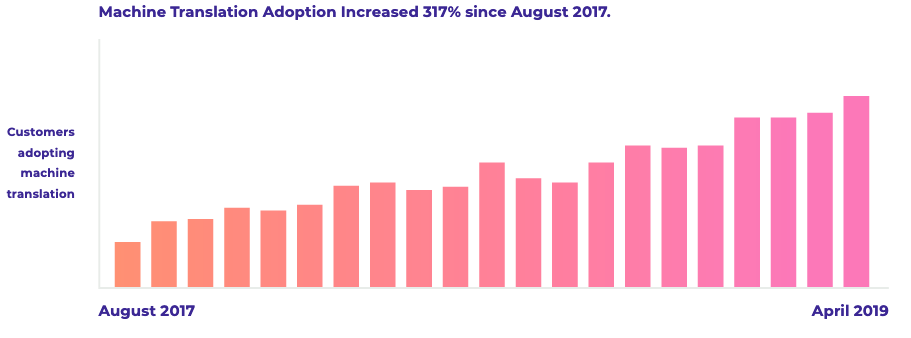Having insight, visibility and analytics around the translation workflow is one of the most useful, yet complicated aspects of translation management.
Many teams have the same questions: How much time do project managers spend assigning content types to different workflows? How often do teams receive completed translations within a reasonable time frame? Is the content worth reviewing internally?
Workflows: Translations From Start to Finish
Even after the initial technology and workflow setup, translation teams still face ongoing manual work, eating into time and resources. For teams with primary responsibilities outside of translation (e.g. marketing, product, communications), translation work pulls their focus away, causing disruption in other projects.
Millions of data points across our customers’ projects reveal an interesting story: people are spending hours each week on manual project management.
To keep content flowing through workflows, customers are overriding or skipping steps, or moving content to completely new workflows. We think customers should spend zero hours managing workflows. This is the beauty of Automated Translation.

Spending Time Manually Reviewing Content
Manual work introduces risk, while automation guarantees completion. For a $250k investment in translations, having almost 40% of your translated content depend on a human to manually intervene in the process puts $100k of your investment at risk.
So, what is an automated workflow?
Translation involves more than just submitting content to a translator. There are edits, revisions, and approvals. (And don’t forget the very last step: publish!) Smartling organizes these steps into workflows.
It’s easy to see who’s in charge of each step and their respective deadlines. Automated workflows enable project managers to oversee translation without needing to shuffle content from one resource to the next - it just happens.
Introducing: Dynamic Workflows
Imagine if your content would intuitively advance through a workflow based on pre-configured settings, without any manual intervention.
We did, and we built it.
Dynamic Workflows enable project managers to create branches in their workflows to automatically direct content to different steps, based on set conditions.
Dynamic Workflows can make the following decisions:
- Publish content that has not yet advanced past Internal Review
- Route content to machine translation vs. human translation based on low vs. high-value content
What you can accomplish with Dynamic Workflows:
- Increase the volume of automated content routing and flow
- Decrease users’ level of manual involvement in translations
To Wait For Review, or Just Publish Already?
Many brands send translations over to an internal employee who speaks the language to review and approve the work before setting them live. This is known as Internal Review.
Internal Review can delay your ability to deliver content to the market. Time is lost when project managers wait for content to be internally reviewed, yet a small percentage of content is actually changed.
At Smartling, we often see cases where content sits in Internal Review for a long time - spanning weeks (and even months!) - with hardly any changes made.

Go live on time.
To ensure content is set live on time, project managers can utilize Dynamic Workflows to automatically publish content after a given number of days.

Machine Translation or Human Translation?
Machine translation (MT), once upon a time, provided only the most basic and often incorrect translations. In recent years, it has become much more powerful.
We see more and more customers taking advantage of the velocity and cost-effectiveness of MT. In the past two years alone, the number of Smartling customers using Machine Translation has increased by over 300%!

Lots of content types, though, still require a human eye to translate artfully and skillfully - especially when it’s brand new content. How can project managers ensure the correct translation method is applied to each piece of content?
Automate Content Routing. Because no single translation method suits all content, Dynamic Workflows can route different types of content to appropriate translation methods. For example, it can route repetitive marketplace listings to MT, while routing more nuanced legal content to Human Translation.
Automated Workflow Management is Now a Reality
We live in a 24/7 economy, where every second, millions of new pieces of information reach consumers around the globe.
By moving translated content from start to publish in a truly automated way, Dynamic Workflows help teams complete translations faster, with far less manual effort and without introducing risk.
Dynamic Workflows direct content to the most appropriate workflow steps, and ensure that translations are set live before your competition gets to the market.








